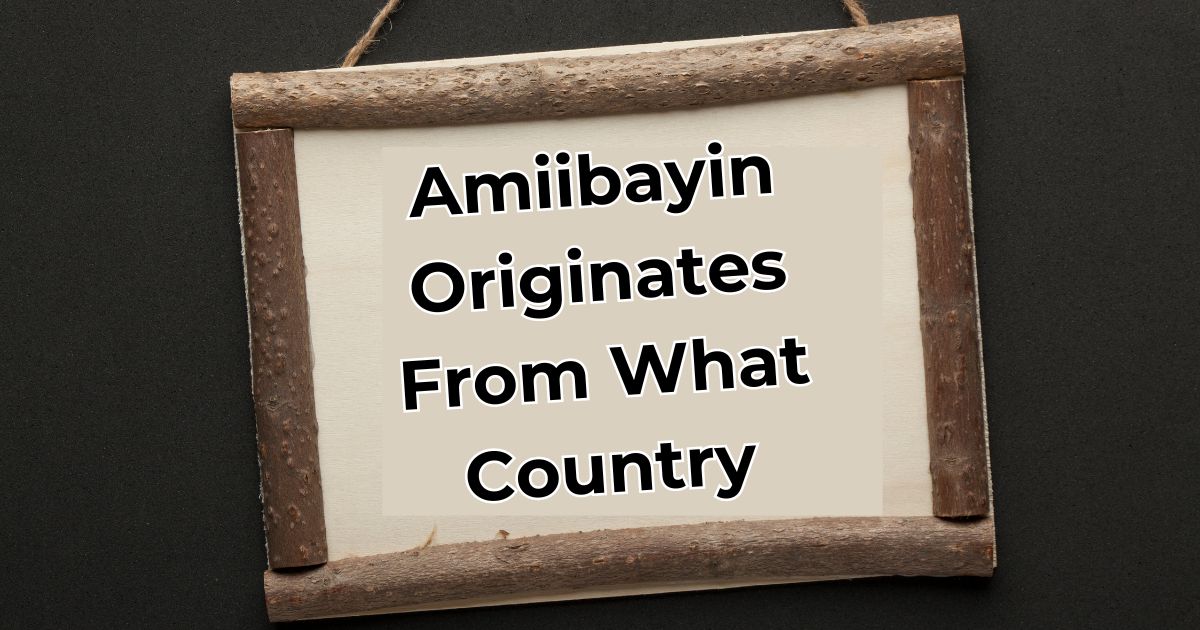Language shapes our understanding of identity and culture. One intriguing term is Amiibayin. This article will explore its origins, cultural significance, and how it has evolved over time. By answering the question, “Amiibayin originates from what country?”, we aim to uncover the complexities surrounding this word.
Amiibayin reflects the rich tapestry of human experience, connecting communities across various regions. This exploration includes linguistic roots, cultural artifacts, and theories about its origins. Join us as we navigate this captivating linguistic journey.
The Etymology of Amiibayin
Understanding the Word’s Roots
To comprehend Amiibayin, we first need to analyze its etymology. Etymology reveals how words evolve, gaining and losing meanings along the way. Amiibayin may derive from roots that signify community and belonging, integral aspects of many cultures. These roots provide a glimpse into how language captures shared experiences.
Linguists often explore connections between languages. In this case, examining Amiibayin can reveal links to terms in related dialects. Such connections highlight the fluid nature of language. As cultures interact, words like Amiibayin adapt and transform. Understanding these roots helps clarify the term’s historical significance.
Linguistic Connections
Linguistic connections deepen our understanding of Amiibayin. Scholars have discovered similarities between this term and others across various languages. Such relationships hint at shared cultural concepts that transcend geographical boundaries. For instance, terms that convey unity and community appear in multiple languages, reflecting a collective human experience.
These linguistic ties illustrate how words can migrate and evolve. As communities exchange ideas, language adapts to new contexts. Amiibayin serves as a testament to this dynamic process. By tracing its connections, we gain insight into how cultures influence each other.
Cultural Significance of Amiibayin
The Role of Community in Identity
Amiibayin embodies the concept of community. Many cultures emphasize the importance of belonging, often reflected in their language. The term symbolizes unity, connection, and shared identity. It represents a collective experience that fosters understanding among diverse groups.
As we explore Amiibayin, we see how it resonates with cultural practices. Festivals, rituals, and social gatherings often emphasize themes of togetherness. This reinforces the notion that Amiibayin is not merely a word but a vital aspect of community life.
Symbolism in Different Cultures
The symbolism of Amiibayin varies across cultures, reflecting diverse perspectives on community. In some cultures, it may represent familial bonds, while in others, it signifies broader social connections. This adaptability highlights the word’s significance as a cultural touchstone.
Art and literature frequently depict themes related to Amiibayin. These creative expressions serve to preserve and celebrate cultural heritage. By examining these artistic representations, we can appreciate the depth of meaning behind Amiibayin.
Historical Context of Amiibayin
Tracing Historical Roots
To understand Amiibayin, we must consider its historical context. Historical records provide insights into how the term was used in past societies. By studying ancient texts and artifacts, researchers can trace the evolution of Amiibayin over centuries.
Archaeological findings also shed light on its usage. Discoveries of inscriptions, pottery, and artifacts can reveal how communities expressed their identities. These findings support the idea that Amiibayin has deep historical roots, reinforcing its significance in various cultures.
The Impact of Migration and Trade
Migration and trade have shaped the development of Amiibayin. As people move and interact, they exchange not just goods but also ideas and language. This cross-cultural exchange enriches the linguistic landscape, allowing terms like Amiibayin to evolve.
The historical context of trade routes is particularly relevant. These routes facilitated cultural interactions, leading to the blending of languages and ideas. Amiibayin emerged as a reflection of these interconnected histories, showcasing the impact of migration on language.
Theories About the Origin of Amiibayin
The Asian Influence Theory
One theory posits that Amiibayin has Asian roots. Linguists note similarities between Amiibayin and certain Asian terms, suggesting a shared heritage. These connections highlight the fluidity of language and how terms migrate and adapt over time.
Exploring this theory reveals the complexities of Amiibayin’s evolution. It showcases the historical relationships between cultures. This perspective suggests that Amiibayin is a reflection of interconnected histories, shaped by interactions across regions.
The African Influence Theory
Another theory involves potential African influences on Amiibayin. Trade routes and migration patterns between Africa and other regions facilitated cultural exchange. Some linguists have identified similarities between Amiibayin and specific African terms, indicating a shared linguistic ancestry.
This theory underscores the rich tapestry of languages in Africa. As communities interacted, they exchanged linguistic elements, leading to the evolution of terms like Amiibayin. The African influence theory emphasizes the importance of historical context in understanding language evolution.
Amiibayin in Modern Contexts
The Globalization of Amiibayin
In today’s interconnected world, Amiibayin transcends its original cultural boundaries. It becomes part of the global lexicon, fostering inclusivity among diverse communities. In contemporary contexts, people use Amiibayin to celebrate shared values and experiences.
Digital platforms and social media facilitate discussions about Amiibayin. Individuals from various backgrounds engage in dialogues that explore its meanings. This cultural exchange enables Amiibayin to resonate with new generations while retaining its historical essence.
Contemporary Uses in Art and Literature
The significance of Amiibayin extends beyond language. It finds expression in art and literature, where artists and writers explore themes of identity and belonging. In literature, Amiibayin may symbolize the struggles of individuals navigating complex cultural landscapes.
In visual arts, Amiibayin can appear in paintings and installations. These artistic expressions celebrate cultural heritage and invite audiences to engage with its meanings. Contemporary uses of Amiibayin underscore its ongoing relevance in cultural discourse.
Cultural Artifacts Linked to Amiibayin
Artifacts Supporting the Origin Hypotheses
Cultural artifacts provide tangible evidence of Amiibayin’s significance. Archaeological discoveries, inscriptions, and relics offer insights into the term’s historical usage. Researchers have uncovered artifacts referencing concepts similar to Amiibayin, reinforcing its cultural importance.
Pottery, carvings, and inscriptions often depict scenes related to community and belonging. These artifacts support various origin hypotheses while illustrating how Amiibayin weaves into cultural practices. By studying these artifacts, we enhance our understanding of Amiibayin’s historical roots.
Symbolism in Ancient Artifacts
The symbolism of Amiibayin often appears in ancient artifacts. Many objects incorporate motifs that resonate with its themes of unity and identity. Ceremonial objects may feature designs that celebrate community, reinforcing the idea that Amiibayin encapsulates shared values.
Additionally, ancient texts may reference Amiibayin, shedding light on its societal role. Examining these symbols helps us understand the beliefs of the cultures that embraced Amiibayin. This exploration emphasizes the relationship between language and culture, showcasing how a single term can encapsulate profound meanings.
Also Read: Acibadem Health Point Knee Replacement
Comparative Analysis: Amiibayin and Similar Terms
Similar Terms in Neighboring Countries
A comparative analysis of Amiibayin with similar terms in neighboring countries reveals fascinating insights. Many cultures share words embodying community, identity, and belonging. Analyzing these linguistic parallels allows researchers to trace the influences shaping Amiibayin’s evolution.
For example, neighboring cultures may develop their versions of the term. These adaptations reflect unique cultural contexts while retaining core meanings. Such interconnectedness emphasizes the fluidity of language, showcasing how cultural exchange leads to shared expressions.
Differences Between Amiibayin and Its Counterparts
While Amiibayin shares similarities with related terms, distinct characteristics set it apart. These differences often stem from the unique cultural contexts in which the term is used. For instance, while similar terms convey community, Amiibayin may emphasize specific aspects of identity that are unique to its culture.
Exploring these differences enriches our understanding of the cultural nuances that shape language. It highlights how terms evolve in response to specific community needs. This nuanced analysis illustrates the richness of language and its capacity to convey diverse cultural experiences.
Amiibayin in Linguistics and Anthropology
How Linguists Study the Word’s Evolution
Linguists employ various methodologies to study Amiibayin. They explore phonetic shifts, morphological changes, and semantic evolution to trace the term’s history. This approach helps identify related words across languages, revealing pathways of development.
Sociolinguistics also plays a vital role in understanding how Amiibayin functions in social contexts. By examining its use in different communities, researchers gain insights into meanings and implications. This perspective illustrates the dynamic relationship between language and culture.
The Role of Anthropology in Understanding Amiibayin
Anthropology contributes to our understanding of Amiibayin by situating the term within broader cultural frameworks. Anthropologists investigate how language, culture, and identity intersect, shedding light on meanings associated with Amiibayin. This exploration goes beyond linguistic analysis, delving into the lived experiences of those who use the term.
Ethnographic research allows anthropologists to observe how Amiibayin is employed in daily life, rituals, and social interactions. This immersive approach captures the nuances of language and the cultural practices that inform its meanings. Studying Amiibayin in context enriches our understanding of how language shapes and reflects cultural identity.
The Impact of Modern Technology on Amiibayin
Digital Platforms and Language Evolution
Modern technology has transformed how we communicate, impacting the evolution of Amiibayin. Digital platforms facilitate the exchange of ideas across cultures, allowing the term to reach new audiences. Social media, blogs, and forums enable discussions that explore Amiibayin in contemporary contexts.
As more people engage with Amiibayin, its meanings expand. Online communities often create spaces to share interpretations and experiences related to the term. This digital engagement reinforces the idea that language is a living entity, continuously adapting to societal changes.
The Role of Social Media in Cultural Exchange
Social media plays a crucial role in cultural exchange, fostering connections between diverse communities. Through hashtags and discussions, users share their interpretations of Amiibayin. This engagement encourages dialogue that deepens understanding of its meanings and significance.
Moreover, social media platforms allow for creative expressions involving Amiibayin. Artists and writers utilize these channels to showcase their work, incorporating the term into their narratives. This modern representation reinforces the relevance of Amiibayin in today’s globalized world.
Conclusion
The exploration of Amiibayin and its origins is a multifaceted journey. By examining its etymology, cultural significance, and historical roots, we uncover the complexities of this term. Understanding Amiibayin reveals its role as a dynamic word reflecting the values of diverse communities. The quest to determine Amiibayin originates from what country highlights the rich connections that transcend geographical boundaries.
Linguistic clues and cultural artifacts highlight the complex web of relationships shaping its evolution. The various theories regarding its origins underscore the fluidity of language and the impact of cultural exchange. In contemporary contexts, Amiibayin has become part of the global lexicon. Its adaptability in changing societal dynamics illustrates the importance of language as a living entity. Through its presence in art and literature, Amiibayin continues to inspire creativity and reflection, testifying to the enduring legacy of language.
Recognizing the broader implications of this journey is essential. Language is more than communication; it reflects identity and shared experiences. The story of Amiibayin reminds us of language’s power to connect individuals, fostering understanding across cultures. Its origins invite us to celebrate linguistic diversity and the cultural narratives that shape our world.










